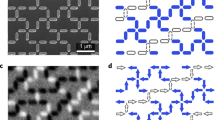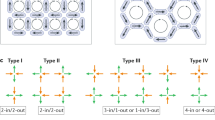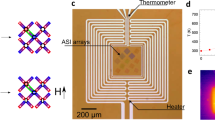Abstract
Systems of interacting nanomagnets known as artificial spin ice1,2,3,4 have allowed the design, realization and study of geometrically frustrated exotic collective states5,6,7,8,9,10 that are absent in natural magnets. We have experimentally measured11,12 the thermally induced moment fluctuations in the Shakti geometry of artificial spin ice. We show that its disordered moment configuration is a topological phase described by an emergent dimer-cover model13 with excitations that can be characterized as topologically charged defects. Examination of the low-energy dynamics of the system confirms that these effective topological charges have long lifetimes associated with their topological protection, that is, they can be created and annihilated only as charge pairs with opposite sign and are kinetically constrained. This manifestation of classical topological order14,15,16,17,18,19 demonstrates that geometrical design in nanomagnetic systems can lead to emergent, topologically protected kinetics that can limit pathways to equilibration and ergodicity.
This is a preview of subscription content, access via your institution
Access options
Access Nature and 54 other Nature Portfolio journals
Get Nature+, our best-value online-access subscription
$29.99 / 30 days
cancel any time
Subscribe to this journal
Receive 12 print issues and online access
$209.00 per year
only $17.42 per issue
Buy this article
- Purchase on Springer Link
- Instant access to full article PDF
Prices may be subject to local taxes which are calculated during checkout




Similar content being viewed by others
References
Wang, R. F. et al. Artificial ‘spin ice’ in a geometrically frustrated lattice of nanoscale ferromagnetic islands. Nature 439, 303–306 (2006).
Heyderman, L. J. & Stamps, R. L. Artificial ferroic systems: novel functionality from structure, interactions and dynamics. J. Phys. Condens. Matter 25, 363201 (2013).
Gilbert, I., Nisoli, C. & Schiffer, P. Frustration by design. Phys. Today 69, 54–59 (2016).
Nisoli, C., Kapaklis, V. & Schiffer, P. Deliberate exotic magnetism via frustration and topology. Nat. Phys. 13, 200–203 (2017).
Morrison, M. J., Nelson, T. R. & Nisoli, C. Unhappy vertices in artificial spin ice: new degeneracies from vertex frustration. New J. Phys. 15, 045009 (2013).
Chern, G.-W., Morrison, M. J. & Nisoli, C. Degeneracy and criticality from emergent frustration in artificial spin ice. Phys. Rev. Lett. 111, 177201 (2013).
Gilbert, I. et al. Emergent ice rule and magnetic charge screening from vertex frustration in artificial spin ice. Nat. Phys. 10, 670–675 (2014).
Gilbert, I. et al. Emergent reduced dimensionality by vertex frustration in artificial spin ice. Nat. Phys. 12, 162–165 (2016).
Perrin, Y., Canals, B. & Rougemaille, N. Extensive degeneracy, Coulomb phase and magnetic monopoles in artificial square ice. Nature 540, 410–413 (2016).
Drisko, J., Marsh, T. & Cumings, J. Topological frustration of artificial spin ice. Nat. Commun. 8, 14009 (2017).
Farhan, A. et al. Exploring hyper-cubic energy landscapes in thermally active finite artificial spin-ice systems. Nat. Phys. 9, 375–382 (2013).
Farhan, A. et al. Direct observation of thermal relaxation in artificial spin ice. Phys. Rev. Lett. 111, 057204 (2013).
Kasteleyn, P. W. The statistics of dimers on a lattice. Physica 27, 1209–1225 (1961).
Castelnovo, C. & Chamon, C. Entanglement and topological entropy of the toric code at finite temperature. Phys. Rev. B 76, 184442 (2007).
Henley, C. L. Classical height models with topological order. J. Phys. Condens. Matter 23, 164212 (2011).
Castelnovo, C., Moessner, R. & Sondhi, S. L. Spin ice, fractionalization, and topological order. Annu. Rev. Condens. Matter Phys. 3, 35–55 (2012).
Jaubert, L. D. C. et al. Topological-sector fluctuations and Curie-Law crossover in spin ice. Phys. Rev. X 3, 011014 (2013).
Lamberty, R. Z., Papanikolaou, S. & Henley, C. L. Classical topological order in Abelian and non-Abelian generalized height models. Phys. Rev. Lett. 111, 245701 (2013).
Henley, C. L. The ‘Coulomb Phase’ in frustrated systems. Annu. Rev. Condens. Matter Phys. 1, 179–210 (2010).
Pauling, L. The structure and entropy of ice and of other crystals with some randomness of atomic arrangement. J. Am. Chem. Soc. 57, 2680–2684 (1935).
Farhan, A. et al. Thermodynamics of emergent magnetic charge screening in artificial spin ice. Nat. Commun. 7, 12635 (2016).
Kapaklis, V. et al. Thermal fluctuations in artificial spin ice. Nat. Nanotech. 9, 514–519 (2014).
Anghinolfi, L. et al. Thermodynamic phase transitions in a frustrated magnetic metamaterial. Nat. Commun. 6, 8278 (2015).
Morley, S. A. et al. Vogel-Fulcher-Tammann freezing of a thermally fluctuating artificial spin ice probed by X-ray photon correlation spectroscopy. Phys. Rev. B 95, 104422 (2017).
Farhan, A., Derlet, P. M., Anghinolfi, L., Kleibert, A. & Heyderman, L. J. Magnetic charge and moment dynamics in artificial kagome spin ice. Phys. Rev. B 96, 064409 (2017).
Stamps, R. L. Artificial spin ice: the unhappy wanderer. Nat. Phys. 10, 623–624 (2014).
Ade, H. & Stoll, H. Near-edge X-ray absorption fine-structure microscopy of organic and magnetic materials. Nat. Mater. 8, 281–290 (2009).
Cheng, X. M. & Keavney, D. J. Studies of nanomagnetism using synchrotron-based X-ray photoemission electron microscopy (X-PEEM). Rep. Prog. Phys. 75, 026501 (2012).
Castelnovo, C., Moessner, R. & Sondhi, S. L. Thermal quenches in spin ice. Phys. Rev. Lett. 104, 107201 (2010).
Banerjee, D. et al. Finite-volume energy spectrum, fractionalized strings, and low-energy effective field theory for the quantum dimer model on the square lattice. Phys. Rev. B 94, 115120 (2016).
Ritort, F. & Sollich, P. Glassy dynamics of kinetically constrained models. Adv. Phys. 52, 219–342 (2003).
Möller, G. & Moessner, R. Artificial square ice and related dipolar nanoarrays. Phys. Rev. Lett. 96, 237202 (2006).
Budrikis, Z., Politi, P. & Stamps, R. L. Diversity enabling equilibration: disorder and the ground state in artificial spin ice. Phys. Rev. Lett. 107, 217204 (2011).
Mostame, S., Castelnovo, C., Moessner, R. & Sondhi, S. L. Tunable nonequilibrium dynamics of field quenches in spin ice. Proc. Natl Acad. Sci. USA 111, 640–645 (2014).
Acknowledgements
The work of Y.L., J.S., D.G. and P.S. was funded by the US Department of Energy, Office of Basic Energy Sciences, Materials Sciences and Engineering Division under grant no. DE-SC0010778. The work of C.N. and F.C. was carried out under the auspices of the NNSA of the US DOE at LANL under contract no. DE-AC52-06NA25396. C.N. wishes to thank the LDRD office for support and C. Castelnovo (University of Cambridge) for very useful discussions. The work of M.S. and K.D. was supported by the NSF through grant CBET 1336634. The work of A.M.A. and J.D.W. was supported by the NSF through grant DMR-1507048. This research used resources of the Advanced Light Source, which is a DOE Office of Science User Facility under contract no. DE-AC02-05CH11231.
Author information
Authors and Affiliations
Contributions
Y.L. and J.S. prepared the lithographic patterns and performed the PEEM experiments with A.S. J.D.W. and A.M.A. prepared the permalloy deposition for the samples. Y.L. and D.G. digitalized the experimental images, analysed the data and rendered the data graphically. F.C. performed the numerical analysis and contributed to the theoretical interpretation. M.S. and K.D. assisted in data analysis. C.N. developed the topological framework for interpretation of the data. P.S. supervised the experimental work and coordinated the entire project.
Corresponding author
Ethics declarations
Competing interests
The authors declare no competing interests.
Additional information
Publisher’s note: Springer Nature remains neutral with regard to jurisdictional claims in published maps and institutional affiliations.
Supplementary information
Extended data figures
Extended data figures 1–11
Supplementary video
The Supplementary Information file initially published online was corrupted and has now been replaced.
Methods
Supplementary methods, supplementary reference
Rights and permissions
About this article
Cite this article
Lao, Y., Caravelli, F., Sheikh, M. et al. Classical topological order in the kinetics of artificial spin ice. Nature Phys 14, 723–727 (2018). https://doi.org/10.1038/s41567-018-0077-0
Received:
Accepted:
Published:
Issue Date:
DOI: https://doi.org/10.1038/s41567-018-0077-0
This article is cited by
-
Kagome qubit ice
Nature Communications (2023)
-
Geometrical control of topological charge transfer in Shakti-Cairo colloidal ice
Communications Physics (2023)
-
Entropy-driven order in an array of nanomagnets
Nature Physics (2022)
-
Direct observation of a dynamical glass transition in a nanomagnetic artificial Hopfield network
Nature Physics (2022)
-
Real-space imaging of phase transitions in bridged artificial kagome spin ice
Nature Physics (2022)



